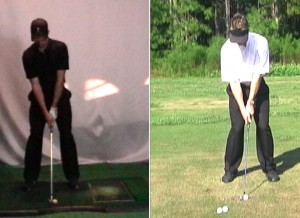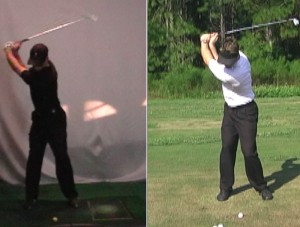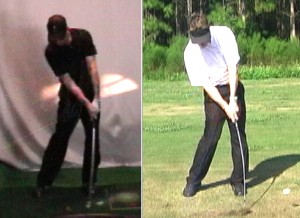To explain all the differences would take a while, so I’m just going to point out a few here that can be seen to help you guys moving along while we prepare to shoot the DVD. The images on the right are from 2005 and the images on the left are from today.
At address, it’s pretty easy to see that my setup has improved significantly. I’m biomechanically better connected to my core at address with my shoulder blades (don’t ask, covered in the DVD!) and my legs are not “knock knee’d” to provide more stability and allow me to rotate against my lower body. I’m also set up with the ball more up in my stance and my head more behind the ball.
At the top of the swing, I’m clearly more “torque’d” up at the top. I no longer allow my hips to rotate back with my upper body, I coil against my lower body and this helps to control the length of my backswing, amongst other things. I’m much more stable here and feel far more powerful.
Needless to say, I have much more control over my ball flight now! My impact position has changed a lot. The shot on the right was a little steep so I was digging a trench, but that just helps illustrate the point. My divots are much shallower now, again, giving me a flatter trajectory and more control over the spin. Before, I was at the mercy of how clean my strike was.
Moral of the story: your golf swing is a journey and you can make tremendous progress, but be patient and enjoy the ride. It lasts a lifetime and I still feel like I improve almost everyday!



















New impact position is incredible. Is your iron trajectory lower?
It’s flatter because I’m not putting as spin on the ball, but I can really hit it high or low now with much more control, particularly when I hit it hard. Before, when I hit it hard it just went straight up in the air unless I moved it way back in my stance and hacked down on it, which caused me to get steep and that introduces more issues.
Yes, the golf swing is indeed a journey. But by God, man, pull back once in awhile and understand the need to score out on the course, recover, and use creativity. I know you know how to do all these things, and probably do them very well. With all due respect, most of us might find this level of navel-gazing excruciating. What did Harvey Penick say?–”Take an aspirin, not the whole bottle!” That said, your blog speaks to the data geek in me, so I’ll keep checking back–especially in the winter months. All the best.
Paul, if I couldn’t score, I wouldn’t be where I am. My short game has always been the best part of my game and always will. Short game is more about feel than anything else. The full swing can be the same way, that’s 1.0. But when you begin to realize the simplicity and power available in proper biomechanics, your eyes open up to a whole new world of possibilities. It’s something you have to experience to understand. Before, I was not all that concerned with getting proper biomechanics throughout in my swing, as long as I was close around impact, I could play golf and so can anyone else. Therefore, swinging like Tiger Woods or other great athletes isn’t for everyone, but if I told you that you could swing like a superb athlete and we have the answers how, would you really not want to? More efficient, injury free, powerful? I’m in.
I don’t understand what you mean by “navel-gazing”.
I am going to play a little devil’s advocate here.
http://www.oneplanegolfswing.com/oneplanemembers/golfbiomechanics/tiger-woods-golf-biomechanics.jsp
I still don’t see you going “vertical” like Tiger and Jamie, as you said Alison loves Jamie’s move. Jamie and Tiger both squat with a closed front hip and then go “vertical”, up and back. There may be something to the squat, jump/twist. I know someone who just added this move to his swing and gained 30 yards and very straight.
Hayes, patience my friend! Work in progress, I’m no where near Tiger or Jamie… Yet! If I was, I’d probably quit my day job. 9 months I’m giving myself, remember? The brain takes time to learn new neural patterns, so I have to be patient and learn the only way my brain knows how. I’m going through a 30 day level 1 workout through Alison’s system that I’m already seeing great progress with, but I still have a long way to go.
9 months I’m giving myself, remember? The brain takes time to learn new neural patterns, so I have to be patient and learn the only way my brain knows how. I’m going through a 30 day level 1 workout through Alison’s system that I’m already seeing great progress with, but I still have a long way to go.
Wow! The changes are just incredible. Can’t wait to be trained in the ways of biomechanics….btu as Tom Petty says “the waiting is the hardest part”
You can always come down in person or go see Alison if you can wait no longer!
The impact position with the left hand over the outside of the left thigh with a flat, or nearly bowed left wrist really makes your 1.0 wrist look almost slightly cupped. Geometrically, this has to be more powerful. Did you think you could have ever gotten there without Alison?
Chuck I live in Orlando, and have played Sugarloaf twice, but Im just wondering if you and Alison need a guinea pig for your models and upcoming DVD’S? Ive been coming to this site for the past 3yrs (only been playing 5yrs) and my scores have dropped from the high 80’s to the mid 70’s just by reading the captions to your videos. But this 2.0 swing has really captivated me, Im addicted, Ive been using these techniques and my ball striking is something I thought was unattainable, but I see and feel the difference and so does my back. I want to know more, I don’t if doing everything correctly, but shot a 78 at Champions Gate this past Saturday. If it was for putting even lower, missed 2 eagle putts and 4 birdies, that’s exciting. The other 3 guys notice a difference, and asked whats going on here, and I let them know about this website, and this new biomechanic golf swing. Im not a member, because I had a bad experince with another web site, and Golf Tech. But I think I’ve been using some of these principles all along, just hungry for more. Hopefully I can get my wife to be a member here : )
Check, my impact position has nothing to do with Alison what so ever in terms of my arms, hands and clubs. She has nothing to do with that side of the swing, just the body. My job is take her understanding of the biomechanics and make it hit a golf ball with my understanding of swing mechanics. The picture above was a bad shot, one that I came in a little steep, but it does illustrate what could happen when things weren’t right.
Terry, I hope you consider joining, if you’re only reading the articles, you are really missing 99% of the site.
Chuck, I wish I could head down to Orlando for a 2.0 lesson. But I was wondering for those of us who can’t wait for the 2.0 DVD and want to learn the new version of the rotary swing would any online instruction purchased now be taught the 2.0 version of the rotary swing? Could give those chomping at the bit a headstart.
Hi Chuck, can you let us all know when the 2.0 DVD will be available? Living in the northeast I use and make any swing changes during the off season (winter) so that way when spring comes I’m well on my way. Looking forward to moving to Rotary Swing 2.0.
Chuck,
I just wanted to let you know that I’ve been following the 2.0 since you started discussing it and started implementing the changes a few weeks ago. While I have only hit balls 3 times in the last
few weeks I’ve been focusing
on the weight staying closer
to me heels and the proper rotation.I went out and played 18 today without hitting any balls and have never struck the ball as consistently. I shot a 76 on a par 70 course
with 35 putts. I know there is plenty more to learn, but the feeling that I could turn through as quick as I wanted to without the fear of spraying the ball all over the yard was phenominal. Keep up the great work and I look forward to more info from you and Allison.
Steve
Chuck,
I’m a 12.2 index and started implementing the 2.0 changes about 3 weeks ago. I’ve only hit balls 3 times since then but have been focusing on keeping the weight near my heels and proper rotation. Got to play 18 today without hitting any balls and shot my personal best score of 76 on a par 70 course with 35 putts. It was a great feeling to just turn as quick as I wanted to without any threat of spraying the ball all over the place. I hit the ball incredibly straight and my only misses were slight fades that were manageable. I know there’s a lot more to learn but I look forward to all you and Allison have to offer. Keep up the good work.
Steve
Chuck–I think you’re doing a great job and I respect what you’re doing. Below comes from “The Way of the Golfer,” Ed Tischler. Peace.
The success rate of the average golfer remains extremely low. For one thing, most golfers don’t truly pay attention to what they are doing as they practice and play. Instead of paying attention, they think too much. The more they think, the more confused they become, and the harder it is to pay attention. The confusion lies in the fact that there are many different viable ways to play. That’s because golfers come in many different shapes and sizes. So, you must develop an approach that accommodates your particular needs. You must find a way of performing the fundamentals naturally.
Imagine this, as your body performs the fundamentals, it does so in your own unique way. As your body does so, your swing will take on a unique look. It will look unique because your body is not built like everybody else. Therefore, the way your body performs the fundamentals will have its own style.
If your fundamentals are sound, then your technique will be sound. This is true no matter how unique your swing looks. To me, all swings on tour are unique. Even the players that have the same technical styles look uniquely different from each other. So, spend more time paying attention to your fundamentals than you do worrying about how your swing looks.
Notice that I said, “ pay attention” to your fundamentals. This is because paying attention is more important than thinking. In many hours spent on the lesson tee, I’ve heard hundreds of students say, ” I know what I am supposed to do, but I cannot do it.” What they really mean is, they know the concept of what they want to do, but are not aware of how to do it. The theories of physics or mechanics tell us what needs to happen, but they don’t tell us how to let it happen. Understanding the concept of what needs to happen involves thinking. Letting the action happen involves being aware. It involves paying attention to what is happening.
When you think about it, all those “how to” books out there are really “what needs to happen” books. They assume we possess the basic skills necessary to perform the given tasks. For example, how to books on carpentry assume you know how to hammer, saw, or use any other tool you need to build something. They don’t teach you how to hammer a nail or drill a hole. They assume you’ve already learned the basic skills through trial and error.
Finally, the essence of the game is simple, and the most simple view of the game is that you must become truly aware of your swing, the ball, and your target. If you do so, you will understand for yourself the best way of getting the ball in the hole. What I’m saying is that you learn through experience. And to learn through experience, you must pay attention to what you’re doing. The more you pay attention to what you’re doing, the more you’ll become aware of what works, and the more you’ll understand how to play great golf. Through this process of awareness you’ll become absorbed in the very lure that attracts you to the game. Fascinated with this entire process, you’ll find the courage to journey beyond the traditional barriers of the game, into a game with new horizons.
Paul, great post. There are two things I would say here. One, Alison has developed a training method with the “How”. That is of ultimate importance. She understands how the brain learns and has a very specific method to educate it so the “How” is not just intellectually understood, but you can now develop the “muscle memory” as well. Secondly, what “fundamentals”? There is no “your fundamentals” and it’s difficult to define a set of “one fundamentals”, atleast until I now. What Alison and I have worked through is one universal set of fundamentals based on biomechanics and science that is absolute no matter how you swing the club. So now, there is actually a set of fundamentals that can apply to everyone that is the most powerful and efficient way to coil and uncoil the body with the correct origin of movement.
Btw, Steve, way to go! Watch this months putting video!
Chuck,
Do you have a date when RS2.0 DVD will be completed and on your website?
Thanks!
Spring ’09